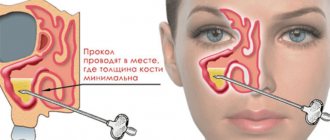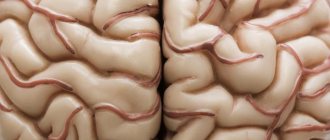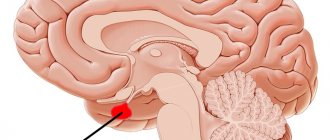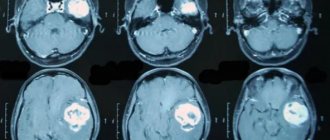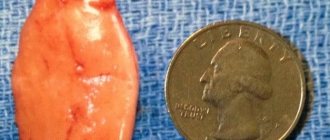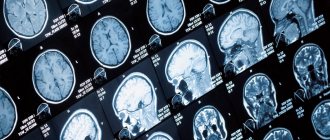MRI of the pituitary gland with contrast is a magnetic resonance examination of the most important endocrine gland of the human body, due to its small size, the use of contrast agents is required. Contrast agents for MRI contain nanoparticles of gadolinium, a metal that can increase the sensitivity and information content of the method. Once in the blood, gadolinium is evenly distributed throughout all tissues of the human body. Inflammatory processes, tumors and other anomalies, on the contrary, lead to local accumulation of contrast, which is why this area stands out in the images, facilitating diagnosis.
Where is the pituitary gland located?
The pituitary gland is the most important organ of the endocrine system (gland), which produces a number of biologically active substances (hormones) that regulate the balance of energy, nutrients and minerals, cell division, sexual functions and reproduction, metabolism and many other aspects of the normal functioning of the human body. This is hard to believe, especially considering the small size of the pituitary gland - only 13 mm in length, 5-6 mm in thickness (the size of a pea or bean). The mass of the pituitary gland does not exceed 0.5 grams.
The pituitary gland is located at the base of the brain, inside the skull, in an area called the sella turcica (due to the shape of the bones, which actually resemble a saddle). The only method for diagnosing pituitary gland diseases that allows obtaining detailed and high-quality images is magnetic resonance imaging. MRI of the pituitary gland is always performed with contrast - this allows to increase the accuracy of diagnosis and the information content of the images, which is important, given the miniature size of the organ.
Normal size of the pituitary gland on MRI
Normal size, weight and volume of the pituitary gland on MRI correlate with gender and age. In pregnant women, enlargement of the pituitary gland is allowed, but after delivery within 6 months the parameters return to the statistical average.
| Size | Magnitude |
| Anteroposterior or sagittal | 0.7 - 1.2 cm |
| Superior-inferior or coronal | 0.6 - 0.9 cm |
| From right to left | 0.7 - 1.0 cm |
| Volume | 0.28 - 0.41 cm cubic. |
Indications and contraindications for MRI of the pituitary gland with contrast
Indications for the use of contrast-enhanced MRI of the pituitary gland:
- pituitary tumors/cysts of various origins;
- metastases to the pituitary gland;
- empty sella syndrome;
- hypofunction of the pituitary gland (decrease in the levels of pituitary hormones - prolactin, somatotropin, TSH, LH, FSH, etc.);
- hyperfunction of the pituitary gland (increased levels of pituitary hormones);
- apoplexy (hemorrhage) in the pituitary gland, pituitary necrosis (Sheehan syndrome);
- Itsenko-Cushing's disease;
- other endocrine disorders associated with the functional activity of the pituitary gland.
Symptoms in which an MRI of the pituitary gland is recommended:
- headache;
- decreased visual acuity (loss of visual fields, double vision, distortion of visible objects);
- excessively short or high stature inappropriate for age, delayed physical development;
- constant thirst with increased fluid consumption and frequent urination;
- infertility, both male and female;
- impotence in men, irregularities or absence of the menstrual cycle in women;
- obesity.
What is forbidden to do before an MRI of the head with contrast?
The basic rules for preparing for a tomographic scan are often set by a specific clinic. Usually, before analyzing the condition of the head, doctors advise not to overeat and stop drinking alcohol. Alcohol has a significant effect on all parts of the brain, which is why it can significantly distort diagnostic data. Before MRI, women of childbearing age fill out a questionnaire about the absence of pregnancy, since examination of patients in the first trimester may adversely affect the development of the fetus.
When scanning, the patient should not have metal objects with him: smartphone, keys, glasses, bank cards and other objects with paramagnetic properties. Electromagnetic examination is contraindicated for persons with metal structures and electronic devices in the body. Such objects can harm the patient and cause damage to the tomograph. Be sure to inform the doctors at the clinic where you are going to undergo an MRI about the presence of tattoos made using dyes with metal particles. Such components are no longer used by tattoo artists today, but if your stylish design is more than 20 years old, then it is better to warn the radiologist.
Contraindications to contrast-enhanced MRI of the pituitary gland
MRI of the pituitary gland with contrast is contraindicated:
- patients who have metal foreign bodies in their bodies (iron filings in the eyes, steel clips on blood vessels, orthopedic structures, etc.) – the metal heats up and can move from its place under the influence of magnetic fields;
- patients with pacemakers, defibrillators, neurostimulators, cochlear implants, insulin pumps - magnetic fields can damage complex electronics;
- pregnant women in the first 13 weeks of pregnancy - MRI is not recommended in the first trimester of pregnancy without good reason;
- children under 5 years of age - MRI in children under 5 years of age is performed in specialized hospitals under anesthesia and medical supervision;
- patients with severe claustrophobia - people with a fear of closed spaces often cannot remain calm and still during an MRI examination.
In addition, MRI diagnostics may be hampered by excess weight (more than 130 kg) and circumference (more than 150 cm in girth) of the body. Patients with such data do not physically fit in the magnetic resonance imaging machine.
Preparation for diagnostics and scanning process
The MRI procedure of the pituitary gland does not require special preparation; the patient is allowed to take food and necessary medications as usual.
Since MRI scanners use a magnetic field and high-power radiofrequency pulses, there are a number of factors that complicate the diagnosis and negatively affect the accuracy of the result:
- non-ferromagnetic implants and hemostatic clips;
- external pacemakers, pumps;
- inner ear prostheses;
- dentures, bridges, braces;
- metal implants in non-scannable organs;
- the need for physiological monitoring;
- tattoos made with metal-containing inks.
The above factors are relative contraindications to MRI, which should be discussed in advance with the specialist conducting the examination. Patients who suffer from asthma, claustrophobia and mental disorders should make healthcare providers aware of these features. In these cases, it is allowed to take sedatives and antihistamines to avoid panic attacks and suffocation.
Before scanning, you must remove all metal objects and accessories from your body. Electronic devices, mobile phones, tablets, watches, magnetic cards should not be in the room with the tomograph. The patient can use clothing offered at the clinic or bring loose clothing that does not contain metal parts. Similar requirements apply to everyone who is near the scanner.
The pituitary MRI procedure takes no more than 40 minutes. The subject is partially placed inside the magnet tunnel. During the diagnosis, you need to breathe evenly, remain calm and keep your head completely still. Communication with the x-ray technician is carried out via a mini-headset. After the first scan, the patient is given a contrast agent and the scan is repeated.
Preparing for MRI of the pituitary gland with contrast
Magnetic resonance imaging of the pituitary gland with contrast agents is performed without any preliminary preparation. The study can be carried out at any time convenient for the patient. The main condition for safe MRI is the absence of foreign metal objects on the patient’s body. Magnetic fields generated during the examination can lead to heating of jewelry, piercings, and metal clothing fittings, with the risk of burns. It is strictly prohibited to carry mobile phones, electronic gadgets, credit and other magnetic cards, storage media, external batteries, etc. Otherwise, injury or burns may occur. The patient can leave anything unnecessary in the storage room.
Contrast drugs very rarely cause side effects - the most common of them is a mild allergy in the form of a small rash and itching on the skin. Severe allergic reactions to contrast are rare and also serve as a contraindication for its administration. In such cases, the study is performed without contrast.
Is MRI with contrast dye harmful?
Currently, there are no absolutely safe contrast agents in medicine. However, gadolinium preparations used for MRI differ from iodine-containing substances in a lower degree of toxicity. Serious anaphylactic reactions are extremely rare.
People with normal kidney function will not be harmed by gadolinium enhancers. In severe pathologies, there is a risk of developing nephrogenic systemic fibrosis. Whether it is possible to perform an MRI with contrast in such a situation is decided after assessing the results of a blood test.
Contrast agent for MR diagnostics Omniscan
There are also a number of relative contraindications to performing the procedure with enhancement:
- hypersensitivity to the components of the drug (individual intolerance);
- burdened allergy history (bronchial asthma);
- severe liver failure;
- severe anemia;
- pregnancy (examination with contrast is carried out in cases of extreme necessity and it is impossible to replace it with other methods);
- early childhood (up to 1 month).
How does a contrast-enhanced MRI of the pituitary gland work?
Magnetic resonance imaging is performed on an outpatient basis, using special equipment - an MRI scanner. The research setup is a large cylindrical block with a tunnel equipped with a special bed on which the patient lies during the examination. A lattice structure resembling a helmet is installed around the patient’s head - this is an additional coil that increases the quality and clarity of images of the brain and pituitary gland.
Before the examination, the patient is asked to wear special headphones - they protect the ears from the noise that occurs during the operation of the tomograph. Headphones can transmit music, which helps the patient relieve stress, and also serve to communicate with the operator. To make an emergency call to the operator, the patient can press a pear-shaped button, which is in his hands at all times during the examination.
The duration of an MRI of the pituitary gland is approximately 30 minutes. In the first half, the study is performed without contrast. Then, 15 minutes after the start of the procedure, the nurse administers an intravenous contrast agent, after which the study is repeated with contrast enhancement.
All that is required of the patient during diagnosis is to lie down, remaining calm and still. MRI is an absolutely safe and painless procedure that is not accompanied by any unpleasant sensations. Slight discomfort may occur in people prone to anxiety and panic attacks due to the limited space of the tunnel.
After completing the examination, you must wait for the images to be decrypted (usually this takes a maximum of 15-30 minutes). The images themselves are recorded free of charge on a CD and sent to the patient along with a written report from the radiologist. If desired, you can record pictures on a flash drive or print them on film.
Referral for MRI and preparation
Most medical centers in St. Petersburg accept patients for tomography of the pituitary gland, both with and without a referral from a doctor. If a person has concerns or doubts about his health, he can independently come to the diagnostic center and voice the problem. Radiologists will help you decide on the area of study, and based on the results of the tomography, advise on further steps. If the patient has any medical history or results of previous examinations, it is better to bring them with you for diagnosis. The tomographic procedure of the head does not require any special preparation from the patient. You can do it any day without having to diet.
Interpretation of the results of MRI of the pituitary gland with contrast
MRI results of the pituitary gland - a series of thin layer-by-layer images of the sella turcica area. Since the pituitary gland is the size of a pea, each section has a minimum thickness of 1 mm. The radiologist carefully examines each image, looking for deviations from the norm. Normal MRI picture of the pituitary gland: dimensions do not exceed 1-1.3 cm, absence of cysts, tumors and other heterogeneous inclusions, the anterior and posterior lobes of the pituitary gland are clearly distinguishable. When administered, the contrast is evenly distributed throughout the pituitary gland. In addition, the condition of the tissues surrounding the pituitary gland - nerve fibers, blood vessels and other anatomical structures - is described.
Local accumulation of contrast is the main sign of the presence of a pituitary tumor. Most often, doctors deal with so-called pituitary adenomas - these are hormonally active tumors that secrete pituitary hormones. An excess of certain hormones leads to endocrine diseases with corresponding symptoms.
Adenomas in the photographs look like formations in the pituitary tissue of arbitrary size, intensively accumulating a contrast agent. Moreover, in the absence of contrast, the tumor may not be visible - very small tumors or microadenomas can hardly be detected without contrast. This is why MRI of the pituitary gland is almost always performed with contrast enhancement.
What should you not do before an MRI of the brain?
On the eve of the study, it is prohibited to drink alcohol; this measure is especially relevant when preparing for contrast MRI of the brain and blood vessels. Ethyl alcohol affects the tone of the walls of veins and arteries, which distorts the picture and complicates the diagnosis of pathological processes.
48 hours before the test, you should not take energy drinks, you should reduce the amount of coffee and other tonic drinks. It is not recommended to overeat on the eve of an MRI, change your usual diet, or eat new foods that can cause an allergic reaction.
Self-administration of medications is prohibited without prior approval from the attending physician. Patients are advised to maintain a sleep schedule 2-3 days before the examination and avoid overwork and stress.
